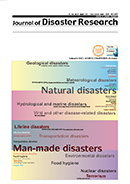16 巻, 2 号
選択された号の論文の24件中1~24を表示しています
- |<
- <
- 1
- >
- >|
Special Issue on Disaster Storytelling, in Commemoration of 2020 TeLL-Net Forum, Kobe, Japan
-
原稿種別: Editorial
2021 年16 巻2 号 p. 125-126
発行日: 2021/02/01
公開日: 2021/02/01
PDF形式でダウンロード (465K) -
原稿種別: Paper
2021 年16 巻2 号 p. 127-134
発行日: 2021/02/01
公開日: 2021/02/01
PDF形式でダウンロード (266K) -
原稿種別: Survey Report
2021 年16 巻2 号 p. 135-140
発行日: 2021/02/01
公開日: 2021/02/01
PDF形式でダウンロード (1172K) -
原稿種別: Note
2021 年16 巻2 号 p. 141-145
発行日: 2021/02/01
公開日: 2021/02/01
PDF形式でダウンロード (1177K) -
原稿種別: Survey Report
2021 年16 巻2 号 p. 146-156
発行日: 2021/02/01
公開日: 2021/02/01
PDF形式でダウンロード (929K) -
原稿種別: Note
2021 年16 巻2 号 p. 157-162
発行日: 2021/02/01
公開日: 2021/02/01
PDF形式でダウンロード (323K) -
原稿種別: Paper
2021 年16 巻2 号 p. 163-169
発行日: 2021/02/01
公開日: 2021/02/01
PDF形式でダウンロード (1323K) -
原稿種別: Letter
2021 年16 巻2 号 p. 170-175
発行日: 2021/02/01
公開日: 2021/02/01
PDF形式でダウンロード (2304K) -
原稿種別: Survey Report
2021 年16 巻2 号 p. 176-181
発行日: 2021/02/01
公開日: 2021/02/01
PDF形式でダウンロード (751K) -
原稿種別: Paper
2021 年16 巻2 号 p. 182-193
発行日: 2021/02/01
公開日: 2021/02/01
PDF形式でダウンロード (669K) -
原稿種別: Paper
2021 年16 巻2 号 p. 194-200
発行日: 2021/02/01
公開日: 2021/02/01
PDF形式でダウンロード (1844K) -
原稿種別: Survey Report
2021 年16 巻2 号 p. 201-209
発行日: 2021/02/01
公開日: 2021/02/01
PDF形式でダウンロード (3017K) -
原稿種別: Survey Report
2021 年16 巻2 号 p. 210-215
発行日: 2021/02/01
公開日: 2021/02/01
PDF形式でダウンロード (533K) -
原稿種別: Survey Report
2021 年16 巻2 号 p. 216-223
発行日: 2021/02/01
公開日: 2021/02/01
PDF形式でダウンロード (725K) -
原稿種別: Letter
2021 年16 巻2 号 p. 224-227
発行日: 2021/02/01
公開日: 2021/02/01
PDF形式でダウンロード (116K) -
原稿種別: Paper
2021 年16 巻2 号 p. 228-233
発行日: 2021/02/01
公開日: 2021/02/01
PDF形式でダウンロード (1411K) -
原稿種別: Review
2021 年16 巻2 号 p. 234-240
発行日: 2021/02/01
公開日: 2021/02/01
PDF形式でダウンロード (194K) -
原稿種別: Survey Report
2021 年16 巻2 号 p. 241-243
発行日: 2021/02/01
公開日: 2021/02/01
PDF形式でダウンロード (376K) -
原稿種別: Survey Report
2021 年16 巻2 号 p. 244-249
発行日: 2021/02/01
公開日: 2021/02/01
PDF形式でダウンロード (243K) -
原稿種別: Paper
2021 年16 巻2 号 p. 250-262
発行日: 2021/02/01
公開日: 2021/02/01
PDF形式でダウンロード (894K) -
原稿種別: Survey Report
2021 年16 巻2 号 p. 263-273
発行日: 2021/02/01
公開日: 2021/02/01
PDF形式でダウンロード (335K)
Regular Papers
-
原稿種別: Paper
2021 年16 巻2 号 p. 275-286
発行日: 2021/02/01
公開日: 2021/02/01
PDF形式でダウンロード (629K) -
原稿種別: Note
2021 年16 巻2 号 p. 287-297
発行日: 2021/02/01
公開日: 2021/02/01
PDF形式でダウンロード (627K) -
原稿種別: Errata
2021 年16 巻2 号 p. 298
発行日: 2021/02/01
公開日: 2021/02/01
PDF形式でダウンロード (180K)
- |<
- <
- 1
- >
- >|
